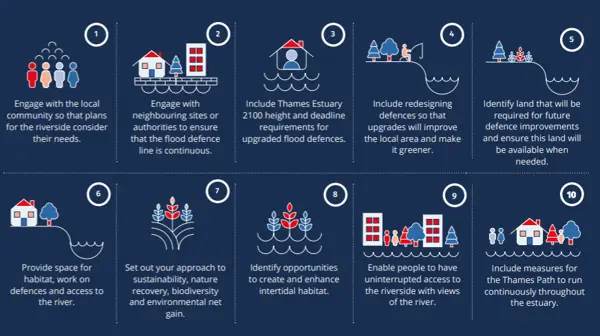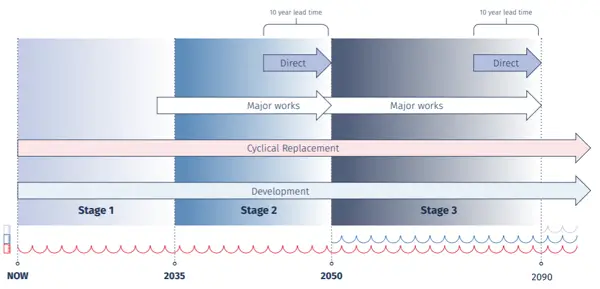City of London Riverside Strategy
In November 2021 the City of London Corporation adopted an ambitious Riverside Strategy to manage the river flood defences in the Square Mile. The strategy sets out the approach to raising the flood defences over the coming century whilst also providing benefits to the workers, residents and visitors that use the Thames river frontage.
The Riverside Strategy follows the Environment Agency's riverside strategy approach set out in the Thames Estuary 2100 (TE2100) plan. This is a holistic approach which looks at making flood defences more resilient to rising sea levels at the same time as creating opportunities for improvement.
The TE2100 plan was reviewed and updated in 2023. The City of London Riverside Strategy was subsequently updated in 2025 to align with the latest TE2100 requirements.

The City Corporation has identified the following four ways that flood defence raising could be delivered in time for the raising deadlines set out in the TE2100 plan:
Where development is proposed on a riparian site the following will be expected at each stage:
Stage 1 (2021-2034): As a minimum the developer must demonstrate that the flood defence is capable of being raised to the future level. Developers are encouraged to implement raising to the 2100 level at this time where feasible.
Stage 2 (2035-2050):As a minimum, when new sites come forward for development during this period. Developers will be required to raise the river defence to at least the 2050 level and demonstrate that future raising to higher level is feasible. Developers should implement raising to the 2090 level at this time where feasible.
Stage 3 (2050 onwards): When new sites come forward for development during this period, developers will be required to raise the river defences to the 2090 level.
Where the City Corporation is responsible for the maintenance of the river defence, should a section need replacing or a major repair, raising opportunities should be evaluated for each stage (other riparian owners should be encouraged to take a similar approach):
Stage 1 (2021-2034): As a minimum the City Corporation must consider the feasibility of raising the river defence as part of the works or at least enabling future raising.
Stage 2 (2035-2050): As a minimum the City Corporation must enable future raising to the 2050 level where feasible and consider the feasibility of implementing to the higher level as part of the works.
Stage 3 (2050 onwards): The City Corporation must consider the feasibility of raising the defence as part of the works and enabling future raising to the higher level.
Riparian owners should take account of river wall raising on adjacent sites and co-ordinate works where feasible.
The City Corporation will work with the Environment Agency and riparian owners to identify stretches where major substantive works will be required to implement raising and seek to ensure that these come forward at the appropriate time such that:
Stage 1 (2021-2034): The City Corporation will have identified the stretches covered by this implementation approach, and instigated planning in conjunction with other stakeholders as required.
Stage 2 (2035-2050): By the end of this period the stretches identified at Stage 1 will have been raised to at least the 2050 level.
Stage 3 (2050 onwards): Further progress on these stretches will have ensured that the defences are raised to the 2090 level before the end of the century.
Where raising is required but has not been fulfilled by the other implementation approaches (including where works have only prepared for future raising) the following should be undertaken:
Stage 1 (2021-2034): The City Corporation will engage with riparian owners to help them understand their legal responsibilities for flood defence raising and the consequences and implications on their sites of future raising.
Stage 2 (2035 – 2050): Stretches still requiring raising ten years before the end of stage 2 will be identified and the City Corporation as Lead Local Flood Authority will work with the Environment Agency to enable riparian owners to fulfil their legal responsibility under The Metropolis Management Act (1879 to 1962) for flood defence raising at least to the 2050 level.
Stage 3 (2050 onwards): Ten years ahead of the end of the century raising date any stretches yet to be raised to the higher level will be identified and the City Corporation as Lead Local Flood Authority will work with the Environment Agency to enable riparian owners to fulfil their legal responsibility for flood defence raising.

The strategy also outlines other areas that will need to be considered to realise the full opportunities of the riverside strategy approach. These are as follows:
The City Corporation will follow the adaptive pathways approach set out in the Thames Estuary 2100 Plan, using the dates and time periods it sets out. The City Corporation will commit to working in partnership with the Environment Agency, neighbouring London Boroughs and other relevant parties to achieve the long-term aims of the Thames Estuary 2100 Plan. The TE2100 Plan was reviewed and updated in 2023. The Riverside Strategy has been refreshed to reflect the latest TE2100 requirements.
Where stretches will require raising in both periods (2050 and 2090), riparian owners or their agents should consider the feasibility of implementing the complete raising in a single intervention and as a minimum demonstrate that the higher level of raising is achievable.
Where raising is being considered, either through immediate works or in preparation for future raising, sufficient consideration shall be given to the adjacent sites and walkway levels to ensure the continuity of the defence and the riverside walk.
Defence raising should maintain access to and improve the accessibility of the existing Thames Path along the City’s riverside and enhance connections with the rest of the City, including during construction.
River safety must be of primary concern and must not be compromised in the design, construction and the ongoing use of the river, flood defences and riverside walk.
Opportunities for terrestrial and aquatic biodiversity should be designed into flood defence raising and associated works to create a ‘string or pearls’ of habitats. Works should consider future raising needs, be designed for future climate projections and not encroach into the river.
The significance of the heritage assets, including their setting, on the riverside must be protected and enhanced and opportunities for education and interpretation included wherever possible.
Designs must take account of the interface between buildings, riverside facilities, infrastructure, walkways and flood defences to maintain functionality, accessibility, and views of the Thames.
All works on the riverside must be designed to maintain views of the river from pedestrian walkways, seating areas, buildings and the lanes and passages between buildings.
Works to the riverside must result in a functional flood defence, effective edge protection and should incorporate principles of good riparian design.
Suitable lighting must be maintained along the riverside but lighting columns should be removed from the flood defence structures to enable future raising, unless they are of historic significance.
You can find out more about the Riverside Strategy by viewing our StoryMap or by looking at the strategy below: